COLORADO, USA —
A teacher greets her students. An imam counsels his congregants. A firefighter reports for duty. New parents take their baby home from the hospital.
These are routine moments in the lives of Coloradans. But the coronavirus has transformed the routine into the remarkable, upending how we live and interact with each other.
As a heavy spring snow blanketed the state on Thursday, April 16, journalists from news organizations across Colorado set out to chronicle a day in the life of the state’s residents during this extraordinary time.
It happened that this day was the deadliest to date in the U.S. for the COVID-19 pandemic. More than 4,500 people died. Colorado’s state health department reported 17 more deaths, and that the death toll had hit 374 -- a figure that the state would later determine was more than 560 as more reports of COVID-19 victims surfaced.
The statewide order to shut down non-essential businesses — issued a month before to the day — had taken a toll. In that month-long period, more than 231,000 people filed for unemployment, just short of the 285,000 unemployment claims filed in all of 2009 during the height of the great recession.
The Colorado stories of April 16 show how much has changed in such a short amount of time. Teachers now instruct students over screens. Doctors speak to patients through masks and face shields. Newborn babies are quarantined from sick parents.
But the journalists also chronicled how, even as Colorado stares down uncertainty, death and illness, life goes on. Birthdays are celebrated. Prayers are said.
And in what feels like a dark hour, there are moments of hope.
>This story is powered by COLab, the Colorado News Collaborative. 9NEWS joined this historic collaboration with more than 20 other newsrooms across Colorado to better serve the public.
7 a.m.: Venture For Success Preparatory Learning Center, Denver


Dressed in purple scrub pants and a coordinated print top, Catherine Scott started her work day with a spray bottle of bleach solution, wiping down door handles, tables and a laptop keyboard.
Scott is not a health care worker, but a preschool teacher — often tasked with opening the child care center where she works in Denver’s Montbello neighborhood.
When children began arriving with their parents, Scott met them at the front door, thermometer in hand. After temperature checks, parents logged their child’s arrival on the laptop, and everybody washed their hands in the sink up front.
Scott, who the youngsters call “Miss Cathy” or “Miss Cappy,” had just three children in her classroom — a 2-, 3-, and 4-year-old — two of them new to the center. It was a far cry from the usual 15 she would have on a day without coronavirus.
After many child care providers closed last month, state officials made a recommendation that caught some by surprise: Stay open, with precautions, to care for the children of working parents.
Scott and her co-teacher recorded morning “circle time” so the video could be posted to a private YouTube channel for children whose parents kept them home. They sang their good morning song in English and Spanish and read the book “Pete the Cat and his Four Groovy Buttons.”
One of the biggest challenges of preschool in the coronavirus era is social distancing. Instead of the usual snuggles and hugs, Scott has switched to distance hugs, air high fives, and pats on the back. One student spontaneously jumped into her lap, then quickly realized her mistake.
“I sorry,” the girl said. “Air high five.”
Ann Schimke, Chalkbeat
8 a.m.: COVID-19 unit, St. Joseph Hospital, Denver


Dr. Peter Stubenrauch reviewed patients’ charts with his medical team during morning rounds and once again weighed the tradeoffs of long-term ventilator use.
Patients getting high levels of oxygen usually are placed on their stomach to ease pressure on the lungs. But that leaves them vulnerable to skin damage as they rest on tubes and equipment.
“Unfortunately, it comes down to an intellectual discussion between how sick are their lungs and how worried are you about the skin,” said Stubenrauch, a critical care pulmonologist with National Jewish Health, which staffs and manages the ICU. “But ultimately the skin wounds should recover (and) we need people oxygenating well enough that they'll hopefully recover from this from a lung standpoint, too.”
Nearly every patient in the unit was on a ventilator, that precious piece of equipment that can be the difference between life and death during the coronavirus crisis.
The medical guidance on COVID-19 is evolving fast. Stubenrauch said doctors use the “tried and true” approaches to respiratory illness and are eyeing experimental treatments being developed. He recommended that one of his patients be added to a promising drug study. If she’s accepted, she could get the drug or a placebo the research requires. He can’t know.
Consultations with families are done by phone. Discussing life and death matters but not face to-face, with family members who can’t even be together with their loved one, is heartbreaking. And the uncertainty about COVID-19 means preparing families for the worst.
“You by no means have any interest in giving up on a patient, particularly someone who came into the intensive care unit relatively recently,” Stubenrauch said. But he must “also set the expectation that we're observing a lot of patients who remain on mechanical ventilation for prolonged periods of time and can quite suddenly take turns for the worse and pass away.”
By his shift’s end, the news in the unit was brighter. There were no new admissions for the day.
Kelley Griffin, CPR News
9 a.m.: Office in the former Morris Elementary School, Yuma

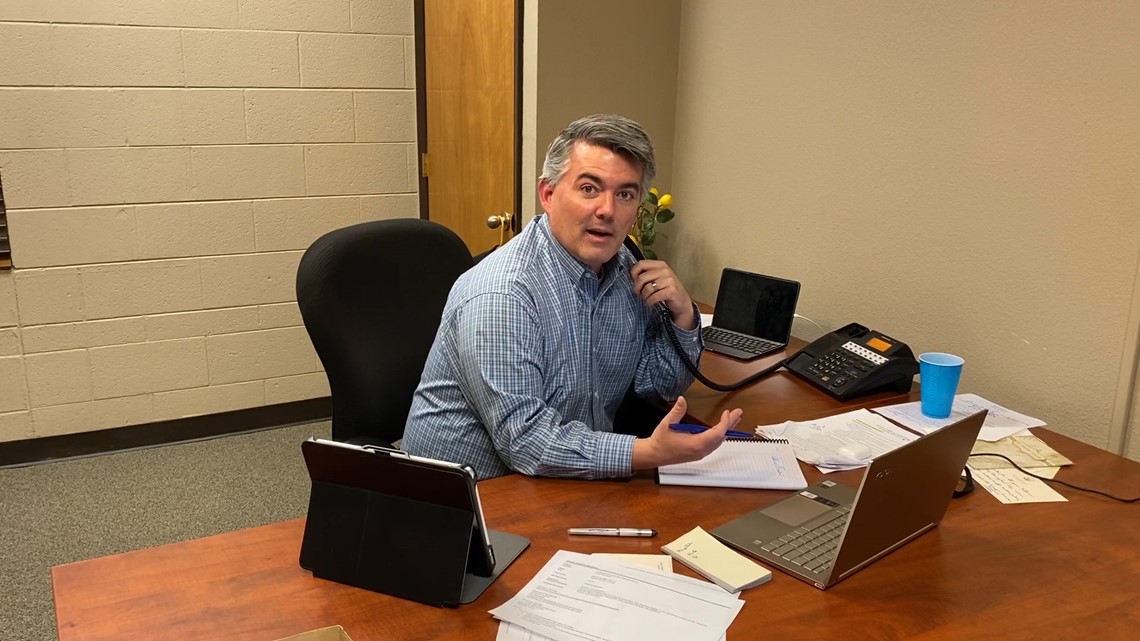
The president of the United States was on the line again.
U.S. Sen. Cory Gardner, elected in 2014 as a rising star in the Republican party, joined other senators on a conference call with President Trump, Vice President Mike Pence and Treasury Secretary Steven Mnuchin. The subject: How to begin reopening America’s economy.
Gardner took the call from a private office in a coworking space carved from the elementary school he attended, and his parents attended before him, in this Eastern Plains town.
It’s close enough to his house that he can get there for lunch and, on this day, make chili for dinner.
Later in the day, Gardner spoke to Gov. Jared Polis about a letter they and Democratic Sen. Michael Bennet were sending to Senate Majority Leader Mitch McConnell informing him of Colorado’s needs. He spoke to banking leaders about nagging problems with the federal Paycheck Protection Program. He conducted a pair of TV interviews.
“Constant calls,” Gardner said. “There are constant calls, scheduled and unscheduled.”
Gardner is up for reelection in November and his seat is considered one of the most vulnerable for Republicans in 2020. His relationship with Trump is central to the campaign, and in recent months the pair have been closely aligned and supportive of each other.
Gardner has been speaking regularly with Trump throughout the crisis. He said the president recently called late at night to pick his brain about trying to bring America back to normalcy.
“I talk to him about what I’m hearing,” Gardner said of the conversations. “He’s asking, ‘How do you think we should reopen the economy, get out of where we’re at right now?’”
Jesse Paul, Colorado Sun
9:10 a.m.: Denver City and County Building

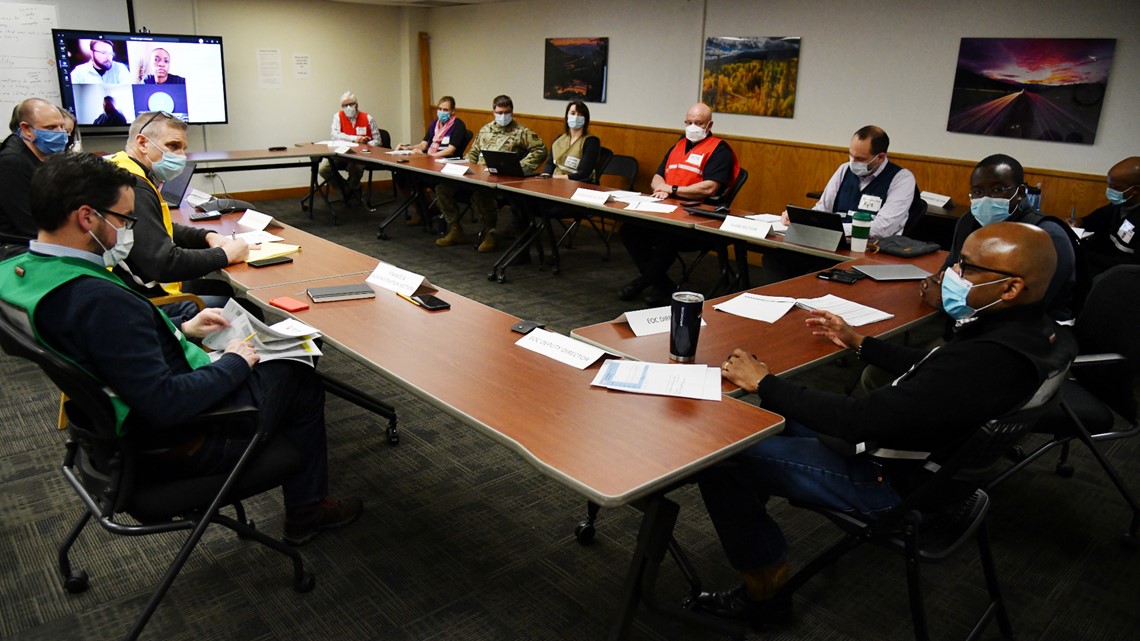
Speaking in a basement room of a mostly quiet City and County building, Denver Mayor Michael Hancock told a dozen Emergency Operations Center staff gathered before him and others watching online that citizens need the safety and security only they can provide.
Hancock’s days are filled with meetings. Questions and concerns pile up with each one.
More residents are ignoring the stay-at-home order he put in place through the end of April to control the spread of the virus. How can Denver ease restrictions equitably? Will businesses hurt more if they open at half capacity? Should there be a curfew?
Hancock’s rollout of the stay-at-home order was not smooth. He initially announced that liquor stores and recreational marijuana shops would be closed before reversing course after long lines formed outside of both across the city, undermining social distancing guidance.
The city government, like public agencies across Colorado, faces a dire loss of tax revenue from virus-prompted shutdowns. Hancock, on a conference call with other metro area city leaders, heard of planned furloughs and open positions left dark, which Denver is considering, too.
"In every challenge, the people are looking for that group of people who are going to stand up and fight on their behalf,” Hancock said. “We're the people. We're the ones."
Conrad Swanson, The Denver Post
11:15 a.m.: Avery Parsons Elementary School, Buena Vista

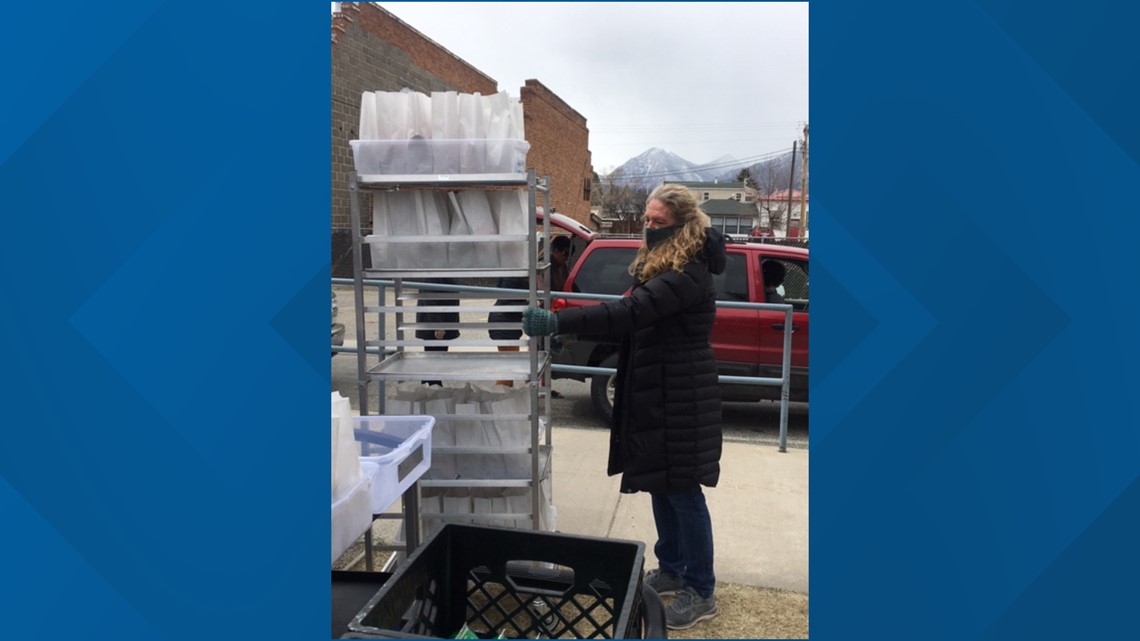
The vehicles pulled into the parking lot on the west side of the school.
Michelle Cunningham was there in a surgical mask and gloves, greeting parents and students by name and giving them thumbs-up signs and smiles in lieu of high-fives and hugs.
The school counselor has been struck by the volume of families showing up for free meals. Though nearly one-third of the school district’s roughly 1,100 students are eligible for government-subsidized lunches, a measure of poverty, only about 40 children a day typically take advantage, she said. Now the district is handing out 400 meals a day, she said.
“As counselors, we know brains work best when physiological needs are met,” Cunningham said. “Its benefits go beyond food. I'm out where I connect with families. We give them a warm smile, a ‘How are things going?'... It's a highlight of the kids' day — a daily field trip to go get your lunch! This check-in connection can make it easier for them to ask for help.”
In communities across the country, school buildings closed for learning remain open for meal distribution, extending a social safety net during the crisis. That holds true in Buena Vista, a tourism-dependent community set amid the majestic Collegiate Peaks.
With retailers, restaurants, and other small businesses closed, hundreds of families are out of work. Many just received their last paychecks. The virus caused the cancellation of a summer whitewater festival in nearby Salida, part of a $75 million rafting season for the local economy.
Even so, Cunningham said she is proud of how the community has rallied.
“The school board, the business owners, the community leaders, the churches, the school's lunch ladies … Everyone is stepping up in so many ways to support each other.”
Jan Wondra, Ark Valley Voice
Noon: Parking lot of the El Jebel Laundromat, Eagle County

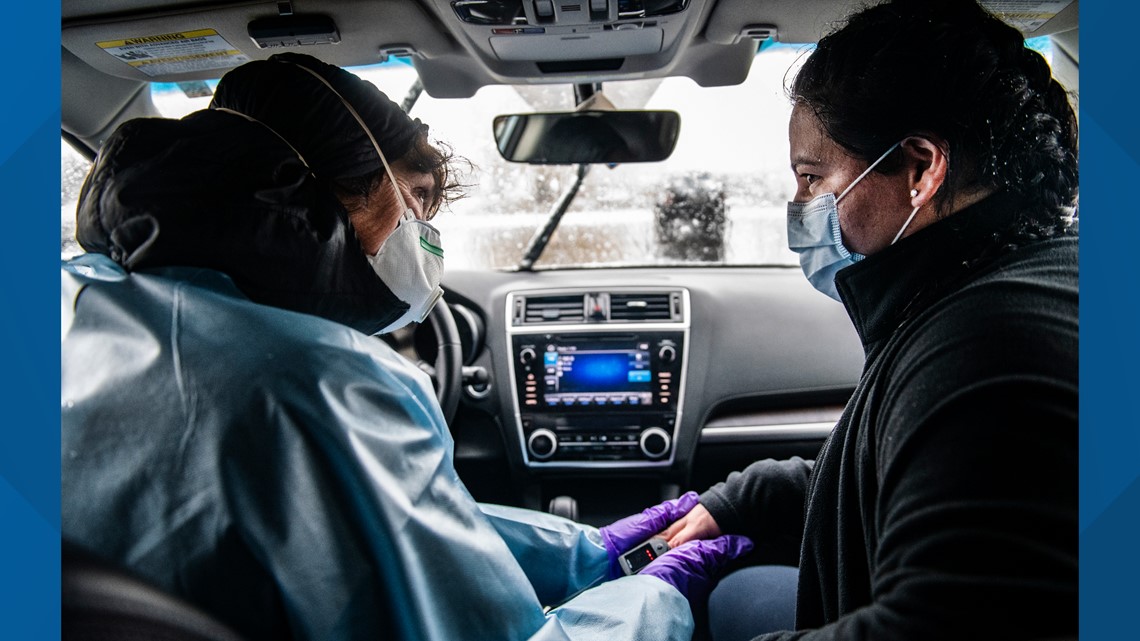
Fabiola Grajales waited for the nose swab that would tell her whether she was finally free of the coronavirus and able to be near her family again.
In one of Colorado’s COVID-19 hotspots, a coalition of Eagle County Public Health, MidValley Family Practice and the Mobile Intercultural Resource Alliance has set up this free mobile testing site. Most patients waiting at the open-sided tent were screened in advance and recommended for the tests after showing symptoms consistent with the coronavirus.
Grajales, 27, a medical assistant at a Glenwood Springs clinic, said she started feeling sick March 2 and tested positive for the virus March 6. Over the next week, her cough worsened and she experienced shortness of breath.
“You know when you step on dry leaves? I could hear that sound coming from my lungs.”
“You get really bad headaches,” Grajales continued. “You feel like your eyes, they’re going to pop out. I couldn’t smell or taste anything.”
Doctors at Grand View Hospital in Rifle confirmed she had pneumonia, which is common among COVID-19 patients, and treated her there but didn’t admit her, she said.
She self-isolated for 10 days before symptoms disappeared. But a follow-up test showed she still had coronavirus. After more rest, Grajales felt “90% better, maybe 95,” she said.
Waiting her turn for yet another test, Grajales said the knowledge and contacts she’s gained working in health care helped her acquire tests and treatment, with some effort.
“It was hard for me,” she said. “I can’t imagine how hard it would be for other people.”
She would need to wait a bit longer to learn whether she was finally well.
Scott Condon, The Aspen Times
12:20 p.m., St. Joseph Hospital emergency room, Denver

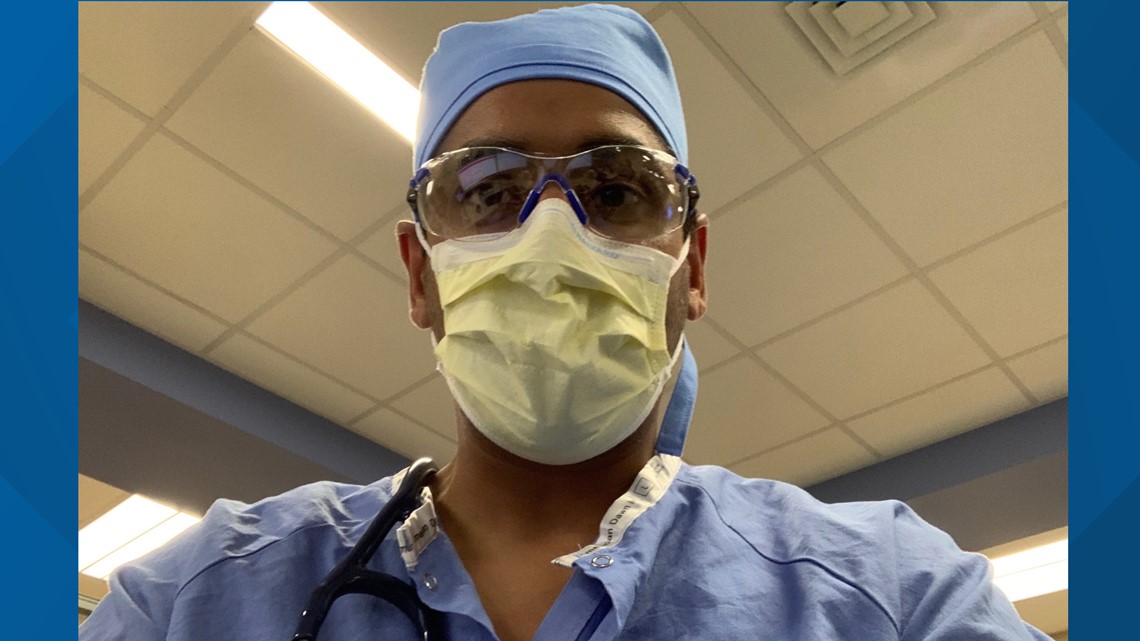
It was another quiet day in the E.R., and the nurses gathered as they do every afternoon to discuss adjusting their schedules. This is a ripple effect of the pandemic: While parts of the health care system are stretched to the limit, emergency rooms are less busy.
“Not gonna lie,” said Dr. Ramnik Dhaliwal, who started his shift at 8. “A little bit bored today.”
More people than ever before are staying home, which means fewer accidents and injuries, Dhaliwal said. He had a patient who suffered a heart attack at home and didn’t go to the ER for three days. He said it’s part messaging — people heeding calls to avoid the hospital unless it’s a true emergency — but also fear of contracting the virus at the hospital.
Like all health care professionals, Dhaliwal wears personal protective equipment, or PPE. That means scrubs, a mask, protective glasses and a scrub hat. He understands the need, but he’s bothered that it takes away from the personal nature of his interactions with patients.
“Hopefully this doesn’t stay like this forever,” he said. “Just waiting for that vaccine.”
The slower traffic to the E.R. compounds the financial pressures facing health-care providers. To make sure resources are adequate to battle the virus, hospitals in Colorado and nationwide have postponed elective medicine including non-emergency surgeries and procedures.
The meeting of the nursing staff ended with the decision to send some home early.
Claire Cleveland, CPR News

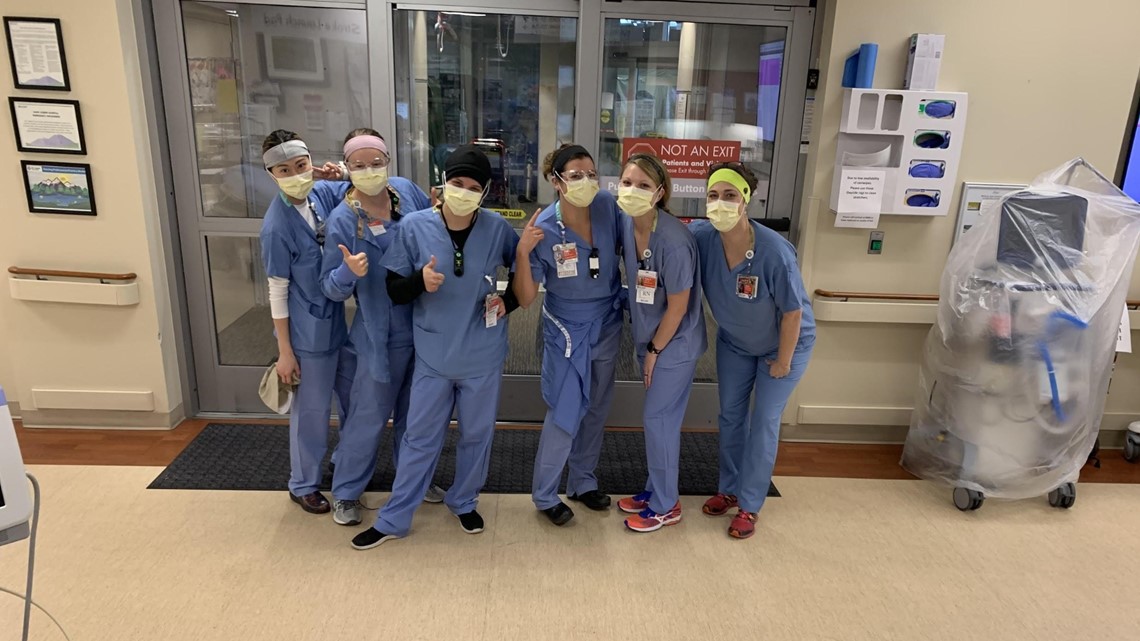
1:30 p.m.: Self-storage locker, Grand Junction

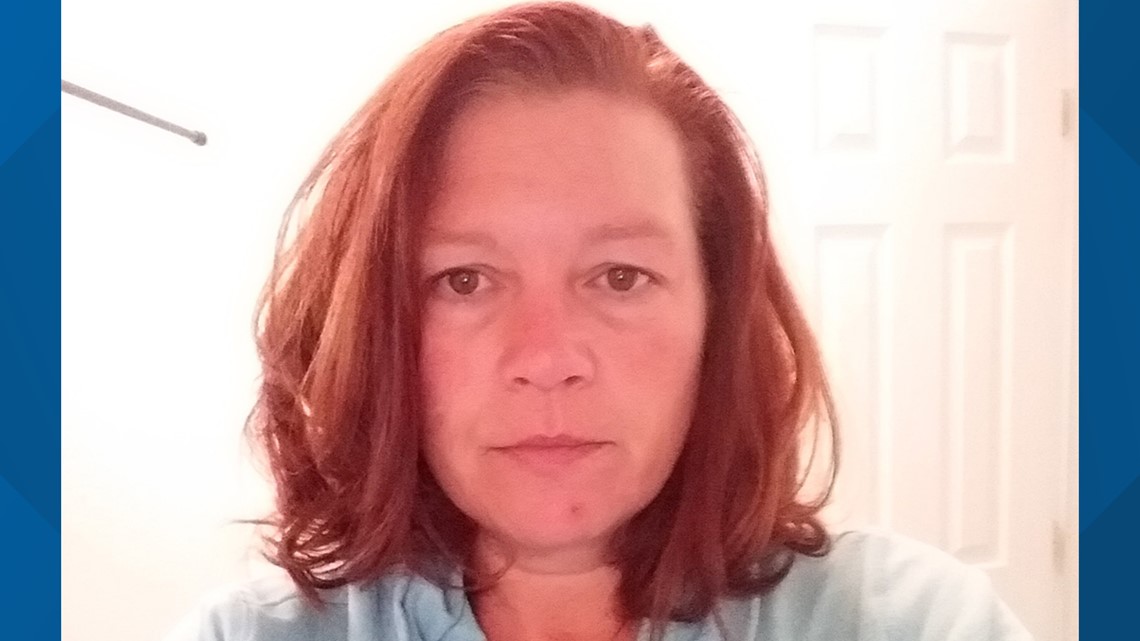
The self-storage yard was empty when Dawna Numbers arrived.
The rain had paused, so the 48-year-old moved quickly to load her clothes in plastic bags into the back of her red Kia for the long journey on a mostly empty interstate.
With no money for rent, Numbers was headed for her mother’s house on the Front Range.
Numbers has been out of work since March 25, when the coronavirus outbreak eliminated her night shift job at a fishing-line factory in Grand Junction. Like many Americans, she had tried fruitlessly to file for unemployment benefits. The state unemployment office had been slammed with more than 231,,000 new claims in the last month, slowing services to a crawl.
Numbers had taken the night job so she could attend physical therapy appointments during the day. She’s worked in the past as a utility locator, a caregiver, and a Lyft driver. She had few options in Grand Junction. Many employers are shut down because of the virus.
“I've never just felt so alone,” she said. Maybe this crisis would bring out something better in people, she hoped. Maybe she’d have better luck in Denver.
“We just need to do the best we can and hopefully this ends soon and somehow we can go back to some kind of normal life,” she said. “Or hopefully better than it was before.”
Andrew Kenney, CPR News
2 p.m.: On the road from Steamboat Springs to Oak Creek

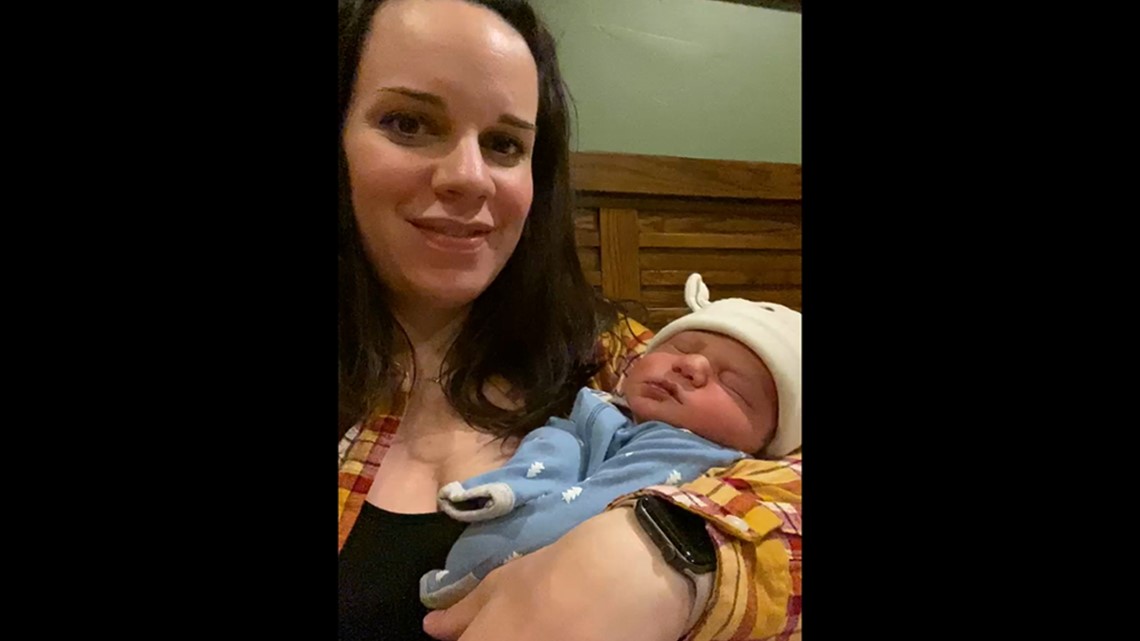
Nolan Christopher Dreher’s parents tucked him into his car seat in the back of their Toyota Highlander and drove snowy roads from Steamboat Springs to their home in Oak Creek. Nolan, cozy in a white onesie with bears on it, was two days old and on his way to meet his brothers.
Lauren Dreher was hoping she had been careful enough, that the nurses and doctors and the woman who came in her hospital room to take out the trash were not infected with the virus.
“At the end of the day you have to know that you did everything you could do,” she said. “I’m just hoping that that’s enough. I was trying so hard not to touch my face. You’re in labor and you brush your hair out of your face and wipe your brow.”
What a weird time to bring a new human into the world, she thought. Will Nolan get a vaccine to protect him against the new coronavirus? What if social norms change so much that her third son never knows a world where people shake hands?
Dreher, who had a complicated second pregnancy, planned to give birth to Nolan in Denver with an at-risk pregnancy specialist. She changed her mind as she watched the number of COVID-19 cases climb in the city. Plus, UCHealth Yampa Valley Medical Center isn’t nearly as busy.
“It was just kind of eerie how quiet it was,” Dreher said. Adding to that surreal feeling was the fact that “everyone you came into contact with was wearing a mask, from the security guard to the nurses and doctors.” Dreher’s delivery team wore N95 masks and face shields.
She was allowed one visitor: her husband, Christopher.
The Drehers are both furloughed. Lauren works for an orthodontist, and Christopher works at a French restaurant in Steamboat. They are trying to look at the bright side -- more time with their new baby and sons Calvin, 6, and Landon, 4.
By late afternoon all were back in their warm home with a fresh blanket of snow outside, the first time together as a family of five.
Jennifer Brown, Colorado Sun
2:30 p.m.: Home of Arapahoe County coroner Dr. Kelly Lear, Centennial

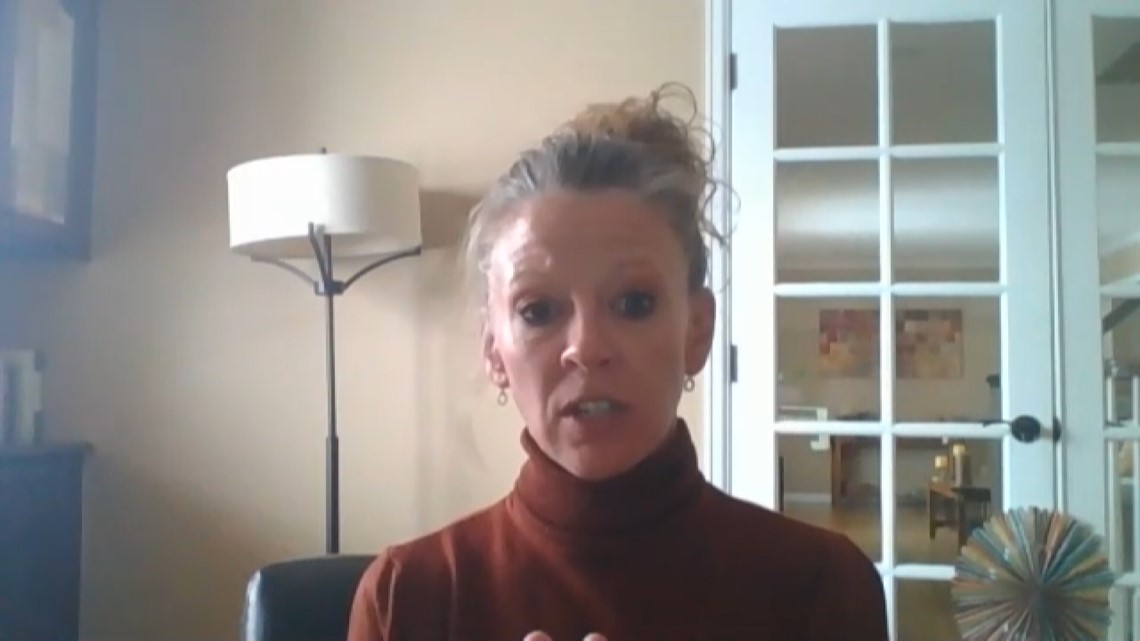
Arapahoe County coroner Dr. Kelly Lear was at home, in jeans and a turtleneck instead of her usual scrubs, handling the administrative tasks that go along with the job since she and her fellow pathologist must stagger days in the office to maintain social distancing.
But she was thinking about a case from early February: The death of a man in his 40s who had been seemingly healthy -- with no serious pre-existing medical conditions – before falling ill with a cough a few weeks earlier. When she examined him then in the sterile autopsy room at the coroner’s office, she discovered lungs ravaged by an infection.
More than two months later, Lear was still searching for answers to why the man died.
The forensic pathologist suspected a virus and had ordered tests to prove it. The results came in mid-March. No flu. No other viruses. Nothing pinpointing what attacked his lungs.
“I was basically ready to sign his death certificate as severe lung disease – unknown infection,” she said.
But emerging news of the novel coronavirus got her thinking.
“He showed all the symptoms and had very severe lung disease – and it looked at autopsy like what we are hearing, you know, COVID-19 lungs look like,” Lear said.
A week later, Lear got the results of specimens she sent to the Centers for Disease Control and Prevention. The man’s test was negative.
Kevin Vaughan, 9NEWS
4:44 p.m.: Masjid Al-Shuhada, downtown Denver

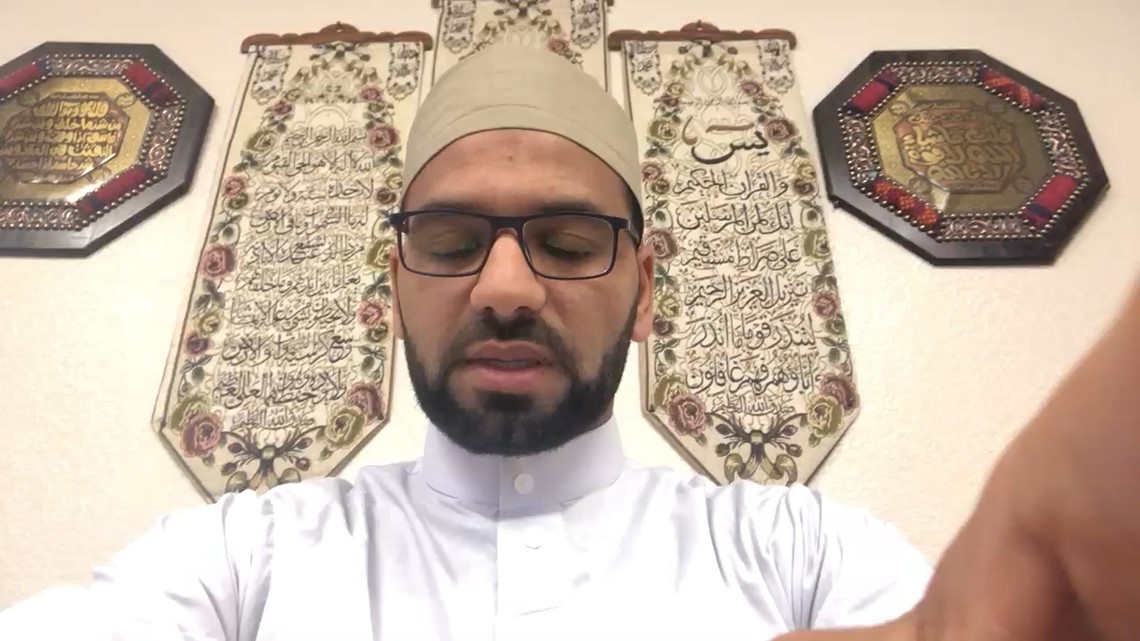
In a building that can hold up to 200 praying together, Imam Muhammad Kolila was alone as he prayed the Salat al-'asr, one of Islam’s five daily prayers.
“One of the things I really miss about community, before coronavirus, is that sense of belonging and that sense of human, physical interactions,” he said afterward. “If we have good intentions, and we lack all the resources and we do our best to pray and make sure we pray in a group, we get the same reward as we would as if we pray in the mosque. And that’s one of the things I’m trying to highlight.”
Kolila has highlighted such teachings online. Like religious leaders of all faith traditions, Kolila has been streaming services — in his case, since March 16 — to provide spiritual direction at a trying time and keep his congregation connected as best he can.
“One of the main objectives and one of the main missions of this mosque is to provide a safe space for people to come and pray, and connect with God, but right now we cannot create that safe space—physically,” he said. “This is why our biggest challenge is to create the space virtually.”
In addition to providing spiritual guidance digitally, Kolila has helped members in need. He regularly delivers food, supplies and money to members. The Muslim holy month of Ramadan was about to begin, providing another test for the imam and his temporarily virtual congregation.
The easing of stay-at-home orders will raise additional questions for Masjid Al-Shuhada and other places of worship: What does praying together look like in the new normal of 2020?
Victoria Carodine, 5280
5 p.m.: Fire Station 52, Brighton


Capt. Colin Brunt climbed into Brighton Fire Rescue Tower 51, a 46-foot long fire truck with a ladder. Trailed by his colleagues in Engine 52, Brunt traveled to Bason Kramer’s house to wish the 5-year-old a happy birthday. When they arrived, the crews switched on their lights and honked their horns while a firefighter stepped out to hand the boy a certificate.
This was not a typical day for the Brighton Fire Department, but it was a welcome one.
Since COVID-19 began to spread, Brunt has worked six 48-hour rotations. Each day of every rotation, he’s responded to multiple COVID-19 medical calls.
When his six-person firefighter and EMS team shows up to a house with a presumed positive case, a paramedic enters the house for reconnaissance while Brunt and his team prepare an ambulance for the patient by wrapping the inside of the cabin with thick plastic.
Before the birthday party, Brunt’s unit extinguished a car fire, helped out on a call of a tractor-trailer hanging off the side of a highway and responded to a fire alarm. Brunt took a mask and worries about exposure to the coronavirus.
“That’s our worst-case scenario that goes through all of our heads, bringing something back to our family,” said Brunt, who is married and has two daughters in kindergarten.
Birthday drive-bys — which more fire departments are doing to lift the spirits of isolated children — and other non-coronavirus calls were a nice change. “It’s a morale booster,” Brunt said.
Liam Adams, MetroWest newspapers
6:30 p.m.: Home of Cat and Zach Garcia, Aurora
Cat Garcia had been waiting for the call from the nurses at the neonatal intensive care unit, hoping to hear good news about her baby twin boys she had yet to meet.
Three weeks earlier, she lay in St. Joseph Hospital about to undergo an emergency cesarean section. Garcia wasn’t due for another six weeks but her doctors felt like they had little choice: She had tested positive for COVID-19, had pneumonia, and was having difficulty breathing.
Bright lights filled the room. Doctors and nurses were covered from head to toe in PPE. The drugs began to take hold, and everything went dark.
When Garcia woke up, she had a breathing tube in her mouth. A nurse held up her phone to show pictures of her newborn sons, Kal and Bruce. It was the closest she was going to get to them.
Her husband, Zach, who works for the Transportation Security Administration at Denver International Airport, had begun to show symptoms of COVID-19 on March 19. Cat Garcia developed a violent cough not long after, and the couple were suddenly facing the prospect of becoming parents in frightening times.
Released from the hospital while Kal and Bruce gained strength in the NICU, Garcia returned home. She pumped milk and unpacked baby clothes while hoping for good news.
When the call came, the news wasn’t good. The twins — both of whom have tested negative for the coronavirus — still weren’t feeding well enough. Watching them on the NICU webcam would have to be good enough for a while longer.
“We haven’t been able to hold them or see them,” Garcia said.
Three days later, the twins were sleeping in car seats on their way home, dressed in matching powder-blue pajamas and hooked up to oxygen to help them breathe.
Adilene Guajardo, Denver 7
11:30 p.m.: Dr. Mercedes Rincon’s home office, Aurora

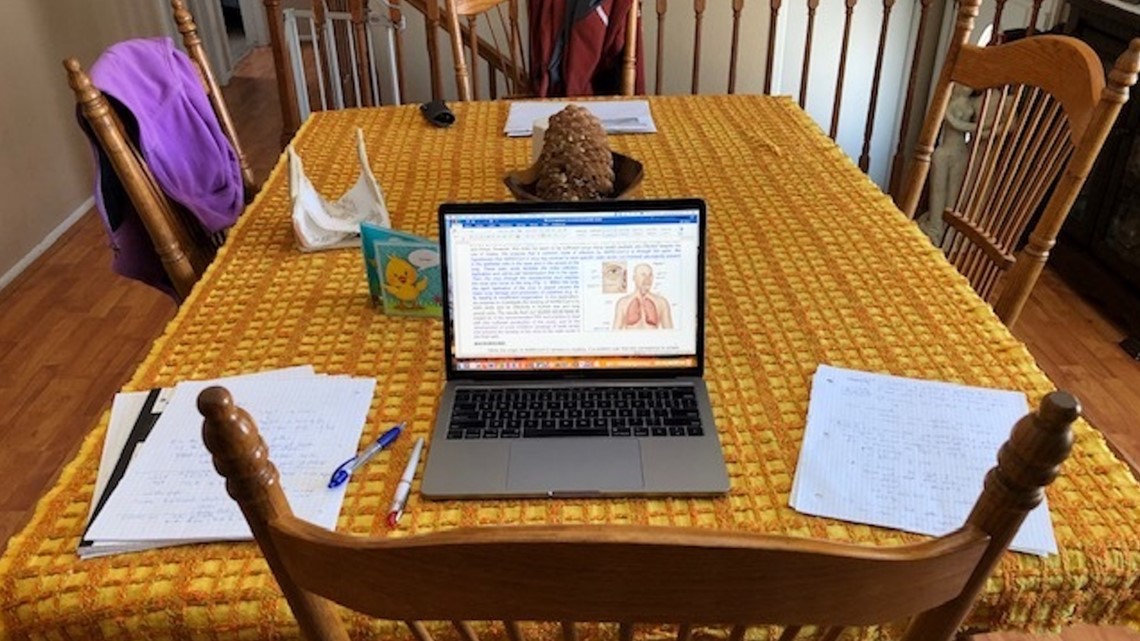
For nearly three decades, Dr. Mercedes Rincon has studied a molecule so obscure and unremarkable that even her colleagues tease her about it.
The Spanish-born professor in the University of Colorado’s Department of Immunology and Microbiology was doing postdoctoral work at Yale when she stumbled upon an article about interleukin-6, or IL-6.
She became fascinated with the molecule commonly produced in inflammation, which is familiar to arthritis and cancer researchers searching for treatments.
When the coronavirus began wreaking havoc on human lungs, Rincon saw a familiar microscopic face in the mix: IL-6 is consistently present in the lungs of the most severely affected patients.
Whether IL-6 is a cause or a consequence of the coronavirus, Rincon isn’t sure. But she hypothesizes that drugs like tocilizumab, traditionally used to treat rheumatoid arthritis, could possibly target IL-6 and prevent it from producing more damaging inflammatory molecules.
Early results from studies in China, as well as research in Europe and at the University of Vermont, show some promise.
“We can’t conclude anything yet,” she cautioned. “We have to be careful. We need more data.”
With the clock approaching midnight, a long day coming to a close, Rincon got to work crafting a grant proposal. She wants the University of Colorado to be at the forefront of this research.
With a little funding and a little luck, Rincon and her obscure molecule might just provide Coloradans — and the rest of the world — with a reason to hope.
Jay Bouchard, 5280
SHARE YOUR STORY
What will you remember most about this historic moment that we’re all sharing? How are you navigating work and family needs? What are your struggles – and silver linings?
History Colorado wants to hear from you about how the outbreak is changing your daily life. Your submission – along with the stories in our COVID Diaries series – will become a part of the state archive, for future generations of Coloradans to learn about this time.
It’s easy to submit a written journal entry, voicemail, or video diary.
SUGGESTED VIDEOS: COVID-19 Coronavirus

